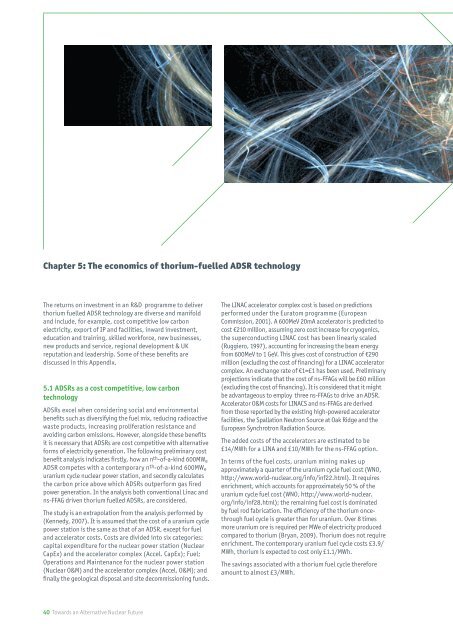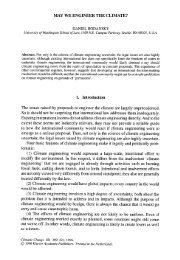ThorEA - Towards an Alternative Nuclear Future.pdf
ThorEA - Towards an Alternative Nuclear Future.pdf
ThorEA - Towards an Alternative Nuclear Future.pdf
Create successful ePaper yourself
Turn your PDF publications into a flip-book with our unique Google optimized e-Paper software.
Chapter 5: The economics of thorium-fuelled ADSR technology<br />
The returns on investment in <strong>an</strong> R&D programme to deliver<br />
thorium fuelled ADSR technology are diverse <strong>an</strong>d m<strong>an</strong>ifold<br />
<strong>an</strong>d include, for example, cost competitive low carbon<br />
electricity, export of IP <strong>an</strong>d facilities, inward investment,<br />
education <strong>an</strong>d training, skilled workforce, new businesses,<br />
new products <strong>an</strong>d service, regional development & UK<br />
reputation <strong>an</strong>d leadership. Some of these benefits are<br />
discussed in this Appendix.<br />
5.1 ADSRs as a cost competitive, low carbon<br />
technology<br />
ADSRs excel when considering social <strong>an</strong>d environmental<br />
benefits such as diversifying the fuel mix, reducing radioactive<br />
waste products, increasing proliferation resist<strong>an</strong>ce <strong>an</strong>d<br />
avoiding carbon emissions. However, alongside these benefits<br />
it is necessary that ADSRs are cost competitive with alternative<br />
forms of electricity generation. The following preliminary cost<br />
benefit <strong>an</strong>alysis indicates firstly, how <strong>an</strong> n th-of-a-kind 600MWe<br />
ADSR competes with a contemporary n th-of-a-kind 600MWe<br />
ur<strong>an</strong>ium cycle nuclear power station, <strong>an</strong>d secondly calculates<br />
the carbon price above which ADSRs outperform gas fired<br />
power generation. In the <strong>an</strong>alysis both conventional Linac <strong>an</strong>d<br />
ns-FFAG driven thorium fuelled ADSRs, are considered.<br />
The study is <strong>an</strong> extrapolation from the <strong>an</strong>alysis performed by<br />
(Kennedy, 2007). It is assumed that the cost of a ur<strong>an</strong>ium cycle<br />
power station is the same as that of <strong>an</strong> ADSR, except for fuel<br />
<strong>an</strong>d accelerator costs. Costs are divided into six categories:<br />
capital expenditure for the nuclear power station (<strong>Nuclear</strong><br />
CapEx) <strong>an</strong>d the accelerator complex (Accel. CapEx); Fuel;<br />
Operations <strong>an</strong>d Mainten<strong>an</strong>ce for the nuclear power station<br />
(<strong>Nuclear</strong> O&M) <strong>an</strong>d the accelerator complex (Accel. O&M); <strong>an</strong>d<br />
finally the geological disposal <strong>an</strong>d site decommissioning funds.<br />
40 <strong>Towards</strong> <strong>an</strong> <strong>Alternative</strong> <strong>Nuclear</strong> <strong>Future</strong><br />
The LINAC accelerator complex cost is based on predictions<br />
performed under the Euratom programme (Europe<strong>an</strong><br />
Commission, 2001). A 600MeV 20mA accelerator is predicted to<br />
cost €210 million, assuming zero cost increase for cryogenics,<br />
the superconducting LINAC cost has been linearly scaled<br />
(Ruggiero, 1997), accounting for increasing the beam energy<br />
from 600MeV to 1 GeV. This gives cost of construction of €290<br />
million (excluding the cost of fin<strong>an</strong>cing) for a LINAC accelerator<br />
complex. An exch<strong>an</strong>ge rate of €1=£1 has been used. Preliminary<br />
projections indicate that the cost of ns-FFAGs will be £60 million<br />
(excluding the cost of fin<strong>an</strong>cing). It is considered that it might<br />
be adv<strong>an</strong>tageous to employ three ns-FFAGs to drive <strong>an</strong> ADSR.<br />
Accelerator O&M costs for LINACS <strong>an</strong>d ns-FFAGs are derived<br />
from those reported by the existing high-powered accelerator<br />
facilities, the Spallation Neutron Source at Oak Ridge <strong>an</strong>d the<br />
Europe<strong>an</strong> Synchrotron Radiation Source.<br />
The added costs of the accelerators are estimated to be<br />
£14/MWh for a LINA <strong>an</strong>d £10/MWh for the ns-FFAG option.<br />
In terms of the fuel costs, ur<strong>an</strong>ium mining makes up<br />
approximately a quarter of the ur<strong>an</strong>ium cycle fuel cost (WNO,<br />
http://www.world-nuclear.org/info/inf22.html). It requires<br />
enrichment, which accounts for approximately 50 % of the<br />
ur<strong>an</strong>ium cycle fuel cost (WNO, http://www.world-nuclear.<br />
org/info/inf28.html); the remaining fuel cost is dominated<br />
by fuel rod fabrication. The efficiency of the thorium oncethrough<br />
fuel cycle is greater th<strong>an</strong> for ur<strong>an</strong>ium. Over 8 times<br />
more ur<strong>an</strong>ium ore is required per MWe of electricity produced<br />
compared to thorium (Bry<strong>an</strong>, 2009). Thorium does not require<br />
enrichment. The contemporary ur<strong>an</strong>ium fuel cycle costs £3.9/<br />
MWh, thorium is expected to cost only £1.1/MWh.<br />
The savings associated with a thorium fuel cycle therefore<br />
amount to almost £3/MWh.



